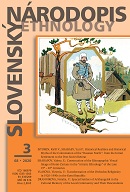Transformation of the Orthodox Religiosity in the 1920s–1990s in the Komi Republic
Transformation of the Orthodox Religiosity in the 1920s–1990s in the Komi Republic
Author(s): Victoria V. VlasovaSubject(s): Christian Theology and Religion, Cultural Anthropology / Ethnology, Interwar Period (1920 - 1939), WW II and following years (1940 - 1949), Post-War period (1950 - 1989), Eastern Orthodoxy
Published by: SAV - Slovenská akadémia vied - Ústav etnológie a sociálnej antropológie Slovenskej akadémie vied
Keywords: religious practice; Soviet; post-Soviet; the Komi Republic; the Russian Orthodox Church; Old Believers; baptism;
Summary/Abstract: This article analyses the influence of Soviet religious politics on society’s attitude to religion, as well as on the transformation of religious practices taking as an example the Komi Republic. I focus on the Orthodox tradition, as the vast majority of residents of the Komi Republic were Orthodox (Russian Orthodox Church, Old Believers). The article starts with a brief review of theoretical approaches to the study of the religious transformations during the Soviet and post-Soviet periods. The churches’ closing in the 1920s – 1930s and their partial reopening in the 1940s – 1950s are used to discuss changes in the manifestation of religiosity in public space. A correlation between gender, age and religious activity is demonstrated. The total control by the state over the church rituals led to a privatization of religious life, which significantly limited both the state and the church control over them. The article also describes how folk religious practices, unrelated to the church, influenced the believers’ resistance and adaptation to the political and ideological changes.
Journal: Slovenský národopis
- Issue Year: 68/2020
- Issue No: 3
- Page Range: 250-272
- Page Count: 23
- Language: English

